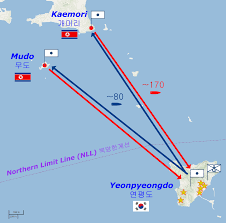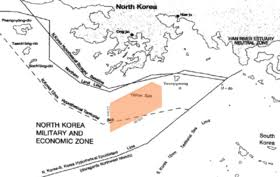Executive summary
The conflict surrounding Yeonpyeong Island in the Northern Limit Line (NLL) between North and South Korea has been a point of conflict for a very long time. The region has witnessed a series of military confrontations since the formation of the NLL in 1953. Since then, the island has witnessed military confrontations which even led to casualties. The most recent one is the event that happened in February of 2024. This report outlines the origin of the conflict, analyzes the key actors and explores the future potential outcomes. The report also identifies possible pathways toward conflict resolution and suggests strategic recommendations for stakeholders.
Introduction
Context: Yeonpyeong Island is situated close to the Northern Limit Line (NLL) in the Yellow Sea. This island has been a flashpoint of the military confrontations between North and South Korea. The proximity of the island to the mainland of North Korea and its disputed maritime boundary has made this region a focal point of naval skirmishes and artillery exchanges.
Purpose: The objective of this report is to give a comprehensive analysis of the conflict between North and South Korea and the relevance of Yeonpyeong Island, assessing the dynamic of military strategies involved. This report also aims to provide recommendations for mitigating the risk of further escalation and achieving a peaceful resolution.
Conflict background
Origin of the conflict:
The United Nations command established the Northern limit line after the Korean War of 1953. This line demarcated the maritime boundaries between the North and the South. But North Korea has never accepted this decision and recognised the NLL. North Korea questioned its legitimacy and considered it unfair as it was too close to the shores. This led to frequent military operations near the line to challenge its legitimacy.
Historical context:
The NLL has witnessed several military confrontations since its formation. The most notable events include the 1999 and 2002 naval skirmishes, the 2010 sinking of the ROKS Cheonan and the 2010 shelling of the Yeonpyeong island, which took several lives of South Korean soldiers and civilians.
· 1999: First Battle of Yeonpyeong
-
- This was the first major naval skirmish near Yeonpyeong. South Korean and North Korean naval forces clashed after North Korean patrol boats crossed the NLL.
- Several casualties occurred on both sides. South Korea successfully defended its waters. The incident highlighted the volatility of the area and the strategic significance of controlling the islands near the NLL.
- 2002: Second Battle of Yeonpyeong
- Another major naval skirmish occurred on June 29, 2002. North Korean patrol boats once again crossed the NLL and a fierce battle erupted between the two. This has resulted in the sinking of a South Korean patrol boat and significant casualties.
- North Korea suffered heavy losses as well. This incident further escalated tensions between the two Koreas and emphasized the strategic military importance of Yeonpyeong.
- 2010: Sinking of the ROKS Cheonan
- On March 26, 2010, a South Korean naval ship, the ROKS Cheonan, was sunk off the coast of Baengnyeong Island, another island near the NLL. 46 South Korean sailors died in the incident.
- An international investigation concluded that a North Korean torpedo was responsible for the sinking, though North Korea denied involvement. This event intensified military tension along the NLL and around Yeonpyeong Island.
- 2010: Yeonpyeong Island Shelling
- On November 23, 2010, North Korean artillery bombarded Yeonpyeong Island which led to the killing of four South Koreans (two soldiers and two civilians) and injuring several others. This marked the first direct artillery attack on South Korean soil since the end of the Korean War.
- The shelling occurred after South Korean military exercises in the area, which North Korea viewed as provocative. South Korea retaliated with artillery fire on North Korean positions.
- This incident was one of the most serious military confrontations between the two countries since the Korean War and drew international condemnation. It underlined the fragile security situation along the NLL and the strategic vulnerability of Yeonpyeong Island.
Key Actors:
North Korea: Pyongyang seeks to assert its claims over disputed maritime regions, often using military provocations to strengthen domestic control and challenge South Korean and U.S. military dominance.
South Korea: Seoul is committed to defending its territorial integrity, maintaining a strong military presence on Yeonpyeong Island, and ensuring the security of its civilians.
Timeline of Events:
1953: NLL was established by the UN command
1999: First Battle of Yeonpyeong: a naval skirmish happened between North and South Korea.
2002: Second Battle of Yeonpyeong led to heavy casualties on both sides.
2010: Sinking of ROKS Cheonan and the shelling of Yeonpyeong Island.
January 2024: North Korea fired several artillery rounds into the waters.
February 2024: North Korea launched cruise missiles in the surrounding areas of the island
Strategies and Tactics: North Korea often utilizes tactics, like surprise artillery attacks and naval incursions well as missile launches. While South Korea implements robust defense measures on its islands to counter these maneuvers and avoid any escalation of tensions with North Korea or threats to regional security and stability entirely by swiftly responding to provocations and maintaining a strong partnership with the United States for additional deterrence.
Power Dynamics: ; The power dynamics, in the Korean Peninsula, reveal a difference between North Korean military posture and South Korea’s defensive tactics coupled with a focus on diplomatic efforts internationally. South Korea benefits from its alliance with the United States which gives it a strong advantage over North Korea. Nevertheless, North Korea’s missile capabilities pose a threat to security. Additionally, the implicit support from China and Russia complicates the power dynamics in the area.
Impact Analysis:
Humanitarian Impact: The conflict on Yeonpyeong Island has adversely affected civilians by causing injuries and displacements. It has also brought anxiety to the residents because of continuous military operations and the potential for future assaults that create fear in the community.
Economic Impact: The economic significance of the region’s fishing resources is vital, for the economy; however maritime conflicts have led to disruptions in fishing operations. Contributed to economic instability in the area overall affecting South Korea’s economic security due to security issues.
Security impact: The conflict around the Yeonpyeong islands and the surrounding areas has created a security dilemma between the North and South which has resulted in the constant escalation of tensions in the Korean peninsula.
Conflict Resolution and Management:
Peace Processes: Several attempts have been made to reduce tensions, such as the 2018 inter-Korean agreements that temporarily de-escalate hostilities. However, North Korea’s continued provocations and missile tests have prevented any lasting resolution. The lack of trust between the two and the involvement of the foreign players has been a hurdle for the de-escalation efforts.
Mediation and International Involvement: The United States and China play crucial roles in diplomatic efforts to manage tensions. While China’s influence over North Korea is significant, it has been reluctant to fully pressure Pyongyang into abandoning its military provocations.
Future Outlook
Yeonpyeong Island represents both a military outpost and a symbol of South Korea’s resilience. North Korea’s attacks are also seen as a challenge to the NLL, making this region a critical hotspot for future provocations. North Korea is likely to continue its increased provocations in the ongoing conflict between North and South. North Korea is undergoing its efforts to modernize its missile and artillery capabilities. The recent events of artillery shelling and missile launches near the NLL and North Korean blasting of roads in DMZ suggest North Korea’s readiness to intensify the provocations it has been speculated that North Korea might leverage its newly advanced submarine-launched ballistic missiles and cruise missile capabilities to pressure South Korea and its allies, including the U.S. The upcoming US elections present a critical moment that North Korea may exploit for strategic gain.
Recommendations
The involvement of major international actors, particularly the U.S. and China, remains a significant factor. North Korea’s primary ally, China and South Korea’s primary ally, the US should abstain from using these countries as their proxies. Even though the US argues that the actions of South Korea are a defensive posture, several actions of the South have also resulted in the escalation of the issue. Thus, diplomatic talks between South Korea and North Korea along with the US and China have to be done to de-escalate the conflict. This should also include various efforts for the mutual utilization of the Yeonpyeong by potentially offering North Korea economic incentives or security guarantees.
South Korea’s reactions are made more difficult by the civilian population on Yeonpyeong Island. Future assaults that target civilian targets or cause large numbers of casualties may put pressure on South Korea to react more forcefully, raising the possibility of a larger conflict. This gives South Korea another obligation to control tensions without escalating hostilities by adding a humanitarian risk dimension.
Conclusion
The Korean peninsula has been a region of contention for a very long time. The involvement of global powers like China, the US, and Russia and their utilization of the Korean peninsula as proxies has been affecting the Korean people for a long time. Yeonpyeong Island was one such island which has been affected by this conflict. The region has been on the verge of conflict since the formation of NLL by the UN. While a full-scale engagement between the North and the South is highly unlikely, provocations from both sides are expected to continue. Diplomatic dialogues between the US and China along with the primary actors are much needed to de-escalate the conflict in the region.
Annexure






Leave a Reply